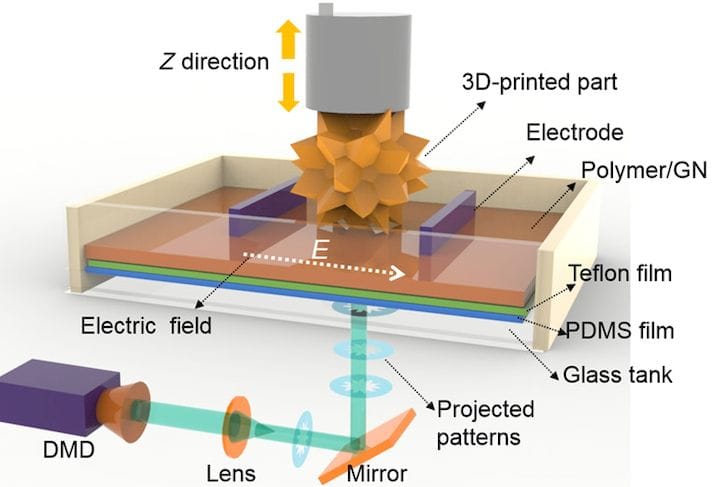![Applying an electric field during 3D printing [Source: ScienceAdvances]](https://fabbaloo.com/wp-content/uploads/2020/05/electric-ov_result_img_5eb0991c73f5d.jpg)
Researchers have developed an incredibly ingenious new method of 3D printing very strong structures using techniques analogous to nature.
Researchers at the University of Southern California were inspired by the material known as “nacre”. You haven’t heard of nacre? More than likely, you have, as it is simply the formal name for “mother of pearl”. That’s the substance that mollusks use to construct their very tough shells.
Why are they so tough? It turns out the secret is in the microscopic structure of the material. Nacre is composed of small “bricks” of calcium carbonate joined together with proteins. These are set in a sophisticated brick-and-mortar style arrangement that provides tremendous strength.
The question is, how could you do this with 3D printing?
Apparently some research has previously been done on generating this type of material in 2D environments. However, according to the researchers, the methods of doing so were quite complex and unlikely to be commercialized.
The researchers came up with an ingenious approach that used the familiar photopolymer resin 3D printing process. The difference was that they first mixed the resin with tiny graphene nanoplatelets. This would normally provide some additional strengths to the resin print, but there was another difference.
![Concept for aligned 3D printed graphene nanoplatelets [Source: ScienceAdvances]](https://fabbaloo.com/wp-content/uploads/2020/05/electric-gns_result_img_5eb0991cd2ced.jpg)
An electric field was employed during 3D printing. This field caused the graphene nano platelets to simultaneously align with each other according to the electric field. When the resin and graphene nanoplatelet mixture solidified, the resulting object had a much stronger microstructure.
The researchers found that this printed substance had a strength more or less equal to that of natural nacre. They also found that the substance had an anisotropic electrical property that is not found in nature.
They explain:
”The bioinspired BM architecture enhances the mechanical strength and electrical conduction by aligning GN in each layer to maximize their performance by crack deflection under loading. The electrically assisted 3D-printing method can build a multifunctional lightweight and strong 3D structure with electrically self-sensing capability.”
![A 3D printed helmet that senses when it is cracked [Source: ScienceAdvances]](https://fabbaloo.com/wp-content/uploads/2020/05/image-asset_img_5eb0991d29a5a.jpg)
In other words, this material could electrically detect when it cracks! This is an incredibly interesting feature with countless practical applications. One application that the researchers suggest is a helmet, which could inform you when it is damaged.
Significant mechanical testing was done on sample prints, and they explained their results:
“The 3D-printed structure with aGNs shows significantly enhanced toughness, impact, and compression resistances due to the synergistic effect and crack deflection. The 3D-printed nacre displays lightweight property with comparable specific fracture toughness to the natural nacre. In addition, the alignment of GNs leads to the anisotropic electrical property, presenting a feasible direction for building protective wearable sensors that can self-sense the crack.”
A very interesting aspect of their process was that they were able to change the alignment of the graphene nanoplatelets for each individual layer of the print. One could easily imagine a sophisticated FEA System being used to devise the optimum alignment strategy for a given part. That would be a very different approach to part design.
Hopefully this approach will be commercialized so that all of us can make good use of it.
Via ScienceAdvances











A research thesis details the incredibly complex world of volumetric 3D printing. We review the highlights.